Highlights from the Rubin collection of Indian art on exhibit in Ewing, N.J.
-

-

-

-

-

-

-

-

-

-

-
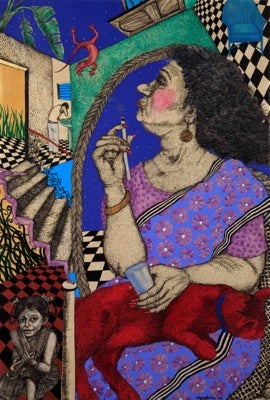
<p>Reminiscing by Chandrima Bhattacharyya.</p>
-
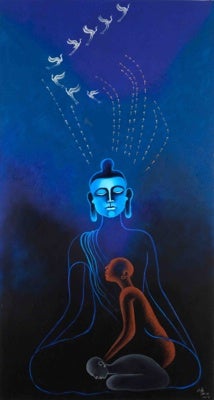
<p>Ascension by Arpana Caur.</p>
-
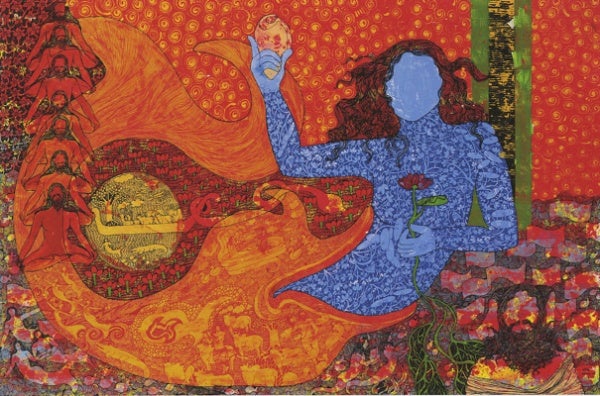
<p>Untitled by Seema Kohli.</p>
-
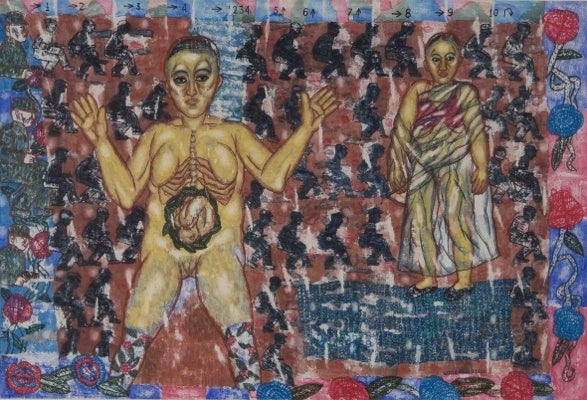
<p>Security Check by Arpita Singh.</p>
-
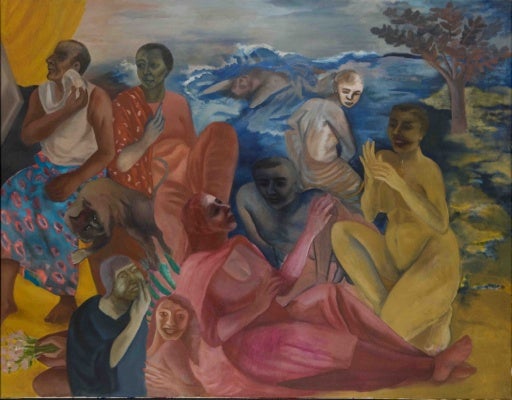
<p>Love, Deception, and Intrigue by Nalini Malani.</p>
This is part of a series from Ilene Dube of The Artful Blogger.
We stretch out in savasana on our yoga mats, spice our food with curry, and our clothing and house wares are infused with Indian design. Here in central New Jersey, Indians R us – neighbors, bosses, top performers in our kids’ schools, readers of this blog. Yet how much do we know about contemporary Indian art?
The Gallery at The College of New Jersey (TCNJ) promises to enlighten us. Through Dec. 16, a selection of the Donald and Shelley Rubin collection is on view in Goddess, Lion, Peasant, Priest: Modern and Contemporary Indian Art.
“A goddess charges forward on a lion, a holy man meditates in a blue field, two oxen pull a plow through a golden landscape: India’s modern and contemporary art brings us a wealth of imagery from all walks of life, from the poorest citizen to dynamic deities,” writes curator Rebecca M. Brown. We see individual characters gazing back at us, men and women inhabiting urban and rural spaces, kneeling bodies meditating and praying.
The Rubin collection
In 1975, former longshoreman Donald Rubin, 39, and his wife, Shelley, became smitten with a pair of Tibetan paintings in a Madison Avenue gallery window. “We had just $3,000 in our bank account, and each painting was $1,500. I didn’t know anything about art. I’d never bought a painting before. I don’t think I’d been in a museum except on a school trip,” Rubin told a group of students from The College of New Jersey.
The Rubins, who went on to earn their fortune in the healthcare business, didn’t even know much about Tibet or Buddhism back in 1975, but felt a connection to the 19th-century paintings.
Traditional Tibetan and Nepalese paintings aren’t signed. That’s OK with Rubin, because when he looks at art, he doesn’t need to know the artist’s name or the price of the work; it’s more important to know how he feels about it. He likens the experience to falling in love – you don’t ask for the person’s resume or letters of recommendation. It’s more about “their energy, their looks, their aura.”
Rubin plunked down $22 million in 1998 and bought the bankrupt Barney’s New York building on 17th Street to house his rapidly growing collection of Himalayan and Asian art. Believing artwork should be seen, in 2004 he founded the Rubin Museum of Art.
Today the Rubin’s is one of the largest Asian art collections, dating to the 11th century and spanning the mountainous Himalayan region to Mongolia, China and Tibet.
In an interview with TCNJ students, Rubin says he prefers to buy art that reflects “real life” rather than abstract art. The selection at the TCNJ Gallery is contemporary representational art.
Window into Indian culture
“The paintings are a window into the extraordinarily rich culture of this part of the world,” says Emily Croll, Director TCNJ Art Gallery. “It’s an overview of Indian painting of the last 50 years. Not only are they beautiful, but they deal with different aspects of modern and contemporary culture and religious practice.”
There is so much going on in these paintings – the more you look, the more you see. The entire universe seems to live in Seema Kohl’s 2007 untitled mixed media work, placed at the center of this exhibit where you can stand back and change your vista of a faceless blue woman whose body seems to end in a mermaid fin, holding an egg in one hand and a red flower with long green roots in the other. Yogis rise around her. Get closer, and there appear to be more mermaids, bearded yogis and sea creatures swirling in a sea. Closer still and in that golden orb within the mermaid’s fin is another world, where animals parade two-by-two under a tree and a mermaid swims with puffer fish, octopi and an alligator.
The orb represents Vishnu giving birth to the universe. Within the fin is a flute player (Krishna). A makara, we learn, is a creature part fish, part elephant, part alligator. The multi-headed figure at bottom right is Brahma, the creator god that Vishnu produces from his navel.
“India’s art has long focused on the human form, whether deities from Hindu traditions, important Islamic saints, enlightened Buddhist figures, or secular historical heroes and heroines,” writes Brown. “After independence in 1947, India’s artists turned to the people around them and found a way to access the tragedies and joys of the emerging, modernized, cosmopolitan country.
“These artists are modern artists in that they address universal issues and seek core truths about humanity, the cosmos or their inner selves,” continues Brown. “And they are also contemporary artists, in that they address the world immediately around them… They offer us insight into the human condition…, exploring the struggles and triumphs of the wide variety of people that share a place in our global conversation.”
Goddess, Lion, Peasant, Priest: Modern and Contemporary Indian Art from the Shelley and Donald Rubin Private Collection is on view through Dec. 16 at TCNJ Art Gallery, TCNJ Center for the Arts, 2000 Pennington Road, Ewing. Gallery hours: Tues.-Thurs. noon-7 p.m., Sun. 1-3 p.m. 609-771-2633.
The Artful Blogger is written by Ilene Dube and offers a look inside the art world of the greater Princeton area. Ilene Dube is an award-winning arts writer and editor, as well as an artist, curator and activist for the arts.
WHYY is your source for fact-based, in-depth journalism and information. As a nonprofit organization, we rely on financial support from readers like you. Please give today.




